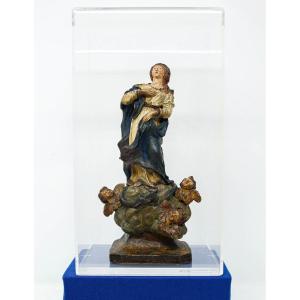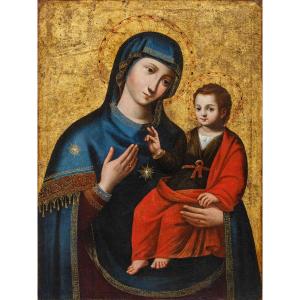Portrait of young man with glass of wine
Oil on canvas, cm 95 x 70
With frame, cm 105 x 80
Born in Comunanza, in the Marche region, in 1660, Amorosi moved to Rome in 1668 with the intention of studying to become a priest. The artistic interest and knowledge of the painter Giuseppe Ghezzi, made him change his mind; at the Roman workshop of Ghezzi Amorosi he started his own training, remaining closely linked to the master for about eleven years. Around 1690, at the age of thirty, Amorosi became independent: his first work, signed and dated 1690, is the Portrait of the child Filippo Ricci, currently part of the Weitzner collection in New York.
In 1699 the artist was awarded the very important commission for the cycle of frescoes of the town hall of Civitavecchia. At the walls of the palace were represented by the painter Pope Innocent III who receives the magistrates of the city and with the Madonna and San Fermo; the wall paintings of the Amorosi were destroyed during the bombing of 1944. In 1702 he painted, in the church of Santa Maria della Morte in Civitavecchia, the altarpiece San Gregorio and the souls of Purgatorio, composition indebted to the art of Carlo Maratta and Sant'Anna, San Domenico and San Giovanni Battista: these works are only the first of a series of altarpieces by the painter; among others, we remember the San Gregorio Nazianzeno of the church of San Biagio in Rome and the Gloria di putti of the church of Sant'Andrea della Valle, always in the Eternal City. In the middle of the 17th century, the first bambocciate were painted representations of scenes of popular life that took their roots in the visual culture of northern Europe, able to witness the dissolution of the classical ideal.Among the favorite subjects of Amorosi there are certainly children, innovatively represented not in the form of putti - as was conventionally done with regard to seventeenth-century painting - but characterized by a strong data of realism: as regards the portraits of children, The most successful are those currently in the Museu Nacional d'Art de Catalunya in Barcelona.
The same realistic vein is also found in this portrait of a young man with a glass of wine: his protagonist is an elegant bourgeois boy, who, probably in a tavern, toasts with a glass of white wine. On the table, a beautiful still life with bread and ham is depicted. Amorosi’s ability to faithfully represent reality catals the attention of art historians: for Zampetti, Amorosi shows "attention to the things of this world, not necessarily seen with the melancholy eye of the Nordic painter, but not for this reason with less sense of human participation on the part of those who, since their difficult childhood spent in a mountain locality, among shepherds and woodcutters, well had to know the difficulties of life and the humility of an existential condition, so profoundly different from that in which he then had to operate, once again in the midst of objective economic and social difficulties", while according to Argan, Amorosi "descends from the Bamboccianti, especially from Cerquozzi, and paints facts of everyday life without any taste for the costume scene. From the Spaniards and especially from Murillo, he learned to consider poor children particularly dear to the Lord and painted them with a full interest of respect. It is not, as has been said, a neo-caravaggesco but is the only exponent, in Rome, of a realistic poetics".
The object is in good condition










































 Le Magazine de PROANTIC
Le Magazine de PROANTIC TRÉSORS Magazine
TRÉSORS Magazine Rivista Artiquariato
Rivista Artiquariato